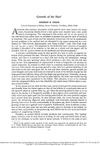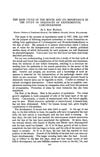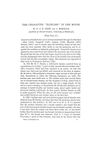TLDR Hairless mice have longer hair follicles and abnormal structures during the catagen phase.
The study focused on the catagen phase of the first hair cycle in hairless (hr) mice, examining morphological and histochemical aspects. Key findings included that the mutant epithelial column shortened at a slower rate, resulting in a greater total follicle length at catagen VII, while the hair shaft's position remained normal. The keratinization sequence of the mutant club appeared normal, but there was a failure to form an anchoring brush due to variations in cell shapes and fibrils. The inner root sheath extended further than normal, enclosing the club. Additionally, the glassy membrane and connective tissue sheath were abnormally narrow, primarily due to reduced collagen and a narrower band of PAS-positive material.
24 citations
,
December 1957 in “Experimental Cell Research” The glassy layer of hair follicles has different fibril sizes and arrangements in guinea pigs and young mice.
 521 citations
,
January 1954 in “Physiological Reviews”
521 citations
,
January 1954 in “Physiological Reviews” Hair growth is cyclic and influenced mainly by local factors.
 111 citations
,
March 1951 in “Annals of the New York Academy of Sciences”
111 citations
,
March 1951 in “Annals of the New York Academy of Sciences” Understanding the mouse hair cycle is crucial for cancer research.
40 citations
,
February 1946 in “Canadian Journal of Research/Canadian journal of research” Hereditary factors cause hair loss in mice by affecting skin and hair follicle structure.
 35 citations
,
November 1931 in “Journal of Genetics”
35 citations
,
November 1931 in “Journal of Genetics” Hairless mice lack fur due to a genetic mutation affecting skin response, not hormone issues.
April 2019 in “The journal of investigative dermatology/Journal of investigative dermatology” A specific mutation in the TRPV3 gene causes hair follicle cells to develop improperly, leading to hair loss.
23 citations
,
February 2004 in “British Journal of Dermatology” Keratin in mouse hair follicles is complex and plays specific roles.
 94 citations
,
February 1994 in “The journal of investigative dermatology/Journal of investigative dermatology”
94 citations
,
February 1994 in “The journal of investigative dermatology/Journal of investigative dermatology” EGF makes hair follicles grow longer but stops hair production.
135 citations
,
November 1987 in “Differentiation” Outer root sheath cells consistently express certain keratins influenced by their environment.
59 citations
,
August 1981 in “PubMed” Trichilemmal keratinization is a unique process in hair follicles where the outer root sheath turns into keratin without a specific layer.



